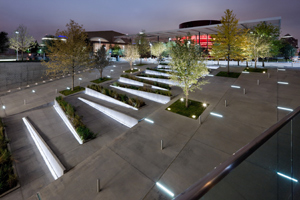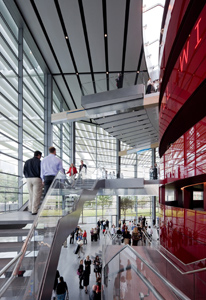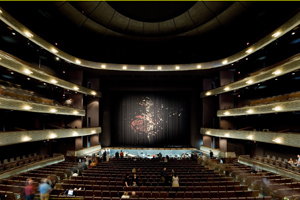 |
 |
 |
 |
 |
 |
| |
 |
|
 |
 |
 |
  |
  |
 |
 |
 |
 |
| FOSTER + PARTNERS' MARGOT AND BILL WINSPEAR OPERA HOUSE OPENS IN DALLAS
|
|
November 3, 2009
 The new Margot and Bill Winspear Opera House in Dallas redefines the opera house for the 21st century, breaking down barriers to make opera more accessible for a wider audience. Responding to the Dallas climate, a solar canopy extends from the building, shading a fully glazed, sixty-foot-tall lobby which enhances the transparency of the building. This establishes a direct relationship between inside and outside, creating greater accessibility and thus a more democratic building. Beneath the canopy, which forms an integral part of the environmental strategy, a shaded pedestrian plaza creates a major new public space for Dallas, as defined by the masterplan designed by Foster + Partners and OMA for the AT&T Performing Arts Center. The new Margot and Bill Winspear Opera House in Dallas redefines the opera house for the 21st century, breaking down barriers to make opera more accessible for a wider audience. Responding to the Dallas climate, a solar canopy extends from the building, shading a fully glazed, sixty-foot-tall lobby which enhances the transparency of the building. This establishes a direct relationship between inside and outside, creating greater accessibility and thus a more democratic building. Beneath the canopy, which forms an integral part of the environmental strategy, a shaded pedestrian plaza creates a major new public space for Dallas, as defined by the masterplan designed by Foster + Partners and OMA for the AT&T Performing Arts Center.
Norman Foster said:
“This project is about the creation of a building that offers a truly democratic experience of opera for the 21st century. We wanted to create a sense of immediacy – from the moment you step into the external plaza to the opening of the curtain – and we wanted the auditorium to be expressed on the outside, the red glass drum is a symbol of performance, the glowing heart of the entire AT&T Performing Arts Center.”
 Internally, behind the glazed screen, there are a series of publicly welcoming spaces, which wrap around the rich red glass drum of the 2,200-seat auditorium. Entered beneath a lower canopy, the transition from the Grand Plaza through the lobby into the auditorium is designed to heighten the drama for those attending a performance — in effect, “taking theatre to the audience.” The grand staircase, flowing from one side to the other around the drum, links all the lobby spaces, providing an opportunity for the audience to pause, talk and observe. Deep cuts into the drum allow the audience to move horizontally around each of the four balcony levels. Internally, behind the glazed screen, there are a series of publicly welcoming spaces, which wrap around the rich red glass drum of the 2,200-seat auditorium. Entered beneath a lower canopy, the transition from the Grand Plaza through the lobby into the auditorium is designed to heighten the drama for those attending a performance — in effect, “taking theatre to the audience.” The grand staircase, flowing from one side to the other around the drum, links all the lobby spaces, providing an opportunity for the audience to pause, talk and observe. Deep cuts into the drum allow the audience to move horizontally around each of the four balcony levels.
 The auditorium for an audience of 2200 is designed to be as intimate as possible. A horseshoe plan combined with the dramatic vertical stacking of its six seating levels ensures that the audience is as close as possible to the stage, thus enhancing the impact of the performance. The distance between the stage and the balcony is only 85 ft—less than the distance between home plate and third base on a baseball field. Intimacy is further reinforced by emphasizing the balcony fronts, with their white gold finish highlighted against the rich dark red interior. The carefully designed acoustics are also enhanced by the compactness of the auditorium. The detail and finishes improve the resonance of the human voice, while making the orchestra sound rich but clear. A chandelier with 320 cascading acrylic tubes of light is drawn up into the ceiling of the auditorium with its two mighty rings, at the beginning of each performance. Argentinean artist Guillermo Kuitca has been commissioned to create a mesmerizing curtain for the stage. The auditorium for an audience of 2200 is designed to be as intimate as possible. A horseshoe plan combined with the dramatic vertical stacking of its six seating levels ensures that the audience is as close as possible to the stage, thus enhancing the impact of the performance. The distance between the stage and the balcony is only 85 ft—less than the distance between home plate and third base on a baseball field. Intimacy is further reinforced by emphasizing the balcony fronts, with their white gold finish highlighted against the rich dark red interior. The carefully designed acoustics are also enhanced by the compactness of the auditorium. The detail and finishes improve the resonance of the human voice, while making the orchestra sound rich but clear. A chandelier with 320 cascading acrylic tubes of light is drawn up into the ceiling of the auditorium with its two mighty rings, at the beginning of each performance. Argentinean artist Guillermo Kuitca has been commissioned to create a mesmerizing curtain for the stage.
The sheltered public areas beneath the canopy benefit from a cool, shaded microclimate. Vertical sliding glass panels moving the full length of the east façade allow the building with its cafe and restaurant to be fully opened up, further enhancing the seamless transition between inside and outside. Behind the café is the Nancy Hammon Hall, designed for smaller scale performances, rehearsals, talks and social events. The Opera House has three stages to allow performances to be rotated in repertory, a fly tower together with dressing rooms, offices and a generous loading dock. |
|
 |
  |
 |
|
|